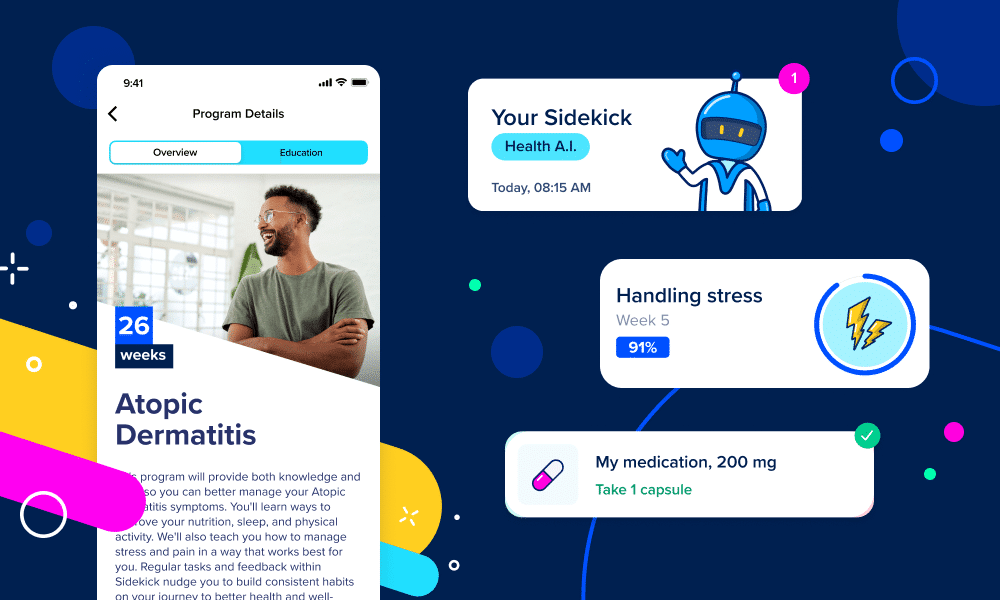|
Getting your Trinity Audio player ready...
|
The word eczema is an umbrella term for a group of conditions that cause irritated, inflamed, and often itchy skin. If you’re living with eczema or you’ve heard of the condition before, it might surprise you to know that there are actually a number of different types of eczema.
In this article, we’ll discuss the 7 most common types of eczema, different types of eczema rashes, and the symptoms and triggers to look out for so that you can effectively understand and manage the condition.
What are 7 common types of eczema?
While some are more common than others, around 31.6 million people in the U.S. have at least one form of eczema; that’s roughly 10 percent of all Americans.
Different types of eczema have different symptoms that require their own treatment plan, and you can suffer from more than one type of eczema at a time.
Here are seven different types of eczema.
- Atopic dermatitis
- Contact dermatitis
- Discoid eczema (also known as nummular eczema)
- Dyshidrotic eczema (also known as palmoplantar or vesicular eczema)
- Neurodermatitis
- Seborrheic dermatitis
- Stasis dermatitis (also known as varicose eczema)
Let’s take a closer look at the different types of eczema as well as their symptoms and triggers.
Atopic dermatitis
Atopic dermatitis (AD) is the most common type of eczema, affecting more than 9.6 million children and about 16.5 million adults in the United States.
The word “atopic” means that the condition is caused by an allergy and can affect any part of the body.
You are more likely to develop atopic dermatitis if one of your parents has had it, and the condition often exists alongside two other allergic conditions: asthma and hay fever.
Symptoms
Symptoms vary from person to person, with 86 percent of people with moderate to severe atopic dermatitis experiencing itching every day. Other symptoms can include:
- Oozing, weeping, or bleeding skin when scratched
- Thickening and hardening of the skin – a process called lichenification
- Rashes – can be anywhere on the body – that may appear purple, brown, or gray in darker skin tones, and red in lighter skin tones
Triggers
We still don’t know exactly what causes atopic dermatitis. But we do know that the skin’s barrier is weakened.
Common triggers include:
- Stress – there are many different types and sources of stress, and everyone experiences stress differently. You can read more about that here.
- Household detergents, cleaning chemicals, soaps, or perfumes.
- Allergies to food, mold, pet dander, dust mites, or tree pollen.
- Certain fabrics, such as wool and synthetics.
- Hormonal changes, often before periods or during pregnancy.
Sidekick’s Atopic Dermatitis program
At Sidekick Health, we create digital programs that aim to improve the lives of people living with chronic conditions.
Our Atopic Dermatitis (AD) program is designed to support you throughout your eczema journey. The program features educational content on eczema and connects you to a health coach so you can access personalized support when you need it.
You can read more about what an AD Sidekick can do for you right here.
Contact dermatitis
Contact dermatitis happens when the skin becomes inflamed after contact with a particular substance. There are two main types of contact dermatitis: irritant and allergic.
Irritant contact dermatitis, which accounts for 80 percent of all contact dermatitis, happens when the skin comes into contact with an irritating substance which, in turn, causes damage to the skin cells.
Allergic contact dermatitis is an allergic reaction that shows up as a rash on the skin a day or two after the skin has come into contact with an allergen.
Symptoms
Contact dermatitis causes a number of different skin problems, including:
- Itchy, crusting, or scaly skin
- Lesions in affected areas
- Hypersensitivity to the sun
- Oozing blisters
Triggers
Substances that can trigger irritant contact dermatitis include:
- Solvents like detergents, soaps, and bleach
- Makeup and hair dye
- Nickel-containing jewelry, belt buckles, or zippers
- Over-washing hands
- Scratchy fabrics such as wool
Substances that can trigger allergic contact dermatitis include:
- Urushiol – found in poison ivy, poison sumac, and poison oak
- Nail polish
- Fragrances
- Nickel
- Thimerosal – a preservative found in some topical antibiotics
Discoid eczema
Discoid eczema, also known as nummular eczema, leads to circular, itchy, and sometimes oozing patches of skin.
The word “discoid” refers to something that’s flat and circular, like a disc. And the word “nummular” comes from the Latin word for “coin,” as the affected areas can look round or coin-shaped.
Nummular eczema can occur at any age and often affects males in their 50s or 60s.
Symptoms
Discoid eczema causes a variety of skin problems, including:
- Coin-shaped lesions on your arms, legs, torso, or hands
- Itching and burning
- Lesions that are oozing liquid or have crusted over
- Discolored, scaly, and inflamed skin around the lesions
Triggers
The causes of discoid eczema aren’t always clear, but triggers can include:
- Very dry skin
- Insect bites
- Scrapes
- Chemical burns
Dyshidrotic eczema
Dyshidrotic eczema, also known as palmoplantar, pompholyx, or vesicular eczema, causes small blisters on the palms of the hands, soles of the feet, and edges of the fingers and toes.
Some people experience dyshidrotic eczema just once, and others live with it as a chronic condition.
It’s thought that the term “dyshidrotic” was first used in the 19th century to describe “disordered sweat”. This suggests that this type of eczema was thought to have been caused by a malfunction of the sweat glands in the hands.
Today, the exact cause of dyshidrotic eczema isn’t actually known.
It is, however, more common in people with another form of eczema. There could also be a genetic component at play, as dyshidrotic eczema tends to run in families.
Symptoms
Symptoms of dyshidrotic eczema can vary greatly and can include:
- Clusters of fluid-filled pimples or small blisters
- Itchy, painful, or burning skin
- Dry, cracked, or scaly skin around the blisters as they dry out
- Thick skin in the areas where blisters once were
- Eczema on the palms of hands and soles of feet
Triggers
Triggers vary from person to person and can include:
- Shampoo or soap
- Nickel or cobalt
- Stress
- Having wet hands for long periods
- Excessive sweating, called hyperhidrosis
Intravenous immunoglobulin therapy: a type of treatment for people with antibody deficiencies
Neurodermatitis
Neurodermatitis is most common in adults between 30 and 50 years of age. It often begins following a stressful or difficult emotional period.
Psoriasis and anxiety disorders can also increase your risk of getting neurodermatitis
Neurodermatitis affects about 12 percent of the population in the US. It can occur anywhere but is most common on the feet, hands, elbows, shoulders, neck, and scalp. The eyelids can also be affected, as can the genital and anal areas.
Symptoms
Symptoms can include:
- Thick, leathery patches of skin
- Pronounced skin lines
- Scales and discoloration
- Open wounds that bleed and scab
Triggers
Neurodermatitis triggers can include:
- Stress
- Tight clothing
- Some fabrics, including wool or synthetics
- Insect bites
- Nerve injury
- Dry skin
Seborrheic dermatitis
Seborrheic dermatitis appears in places on the body where there are a lot of oil-producing – or sebaceous – glands, like the upper back, nose, between the eyebrows, and on the scalp.
Certain medical conditions can increase your risk of developing seborrheic dermatitis, including psoriasis, HIV, acne, rosacea, Parkinson’s disease, epilepsy, alcoholism, depression, and eating disorders.
Around 11 percent of the general population lives with seborrheic dermatitis.
Symptoms
Seborrheic dermatitis can cause a variety of symptoms, including:
- Flaking skin or dandruff
- Itchy rash on the affected area
- White or yellow scales on top of greasy skin
- Rashes – can be anywhere on the body – that may appear purple, brown, or gray in darker skin tones, and red in lighter skin tones
Triggers
Common seborrheic dermatitis triggers include:
- Stress
- Hormonal changes or illness
- Harsh detergents, solvents, chemicals, and soaps
- Changes in weather or temperature
- Some medications, including psoralen, interferon, and lithium
Stasis dermatitis
Stasis dermatitis, also known as venous eczema, happens when there is poor circulation in your lower legs and fluid leaks from weakened veins. Stasis dermatitis most frequently affects people with poor circulation, usually those over 50.
The term “stasis” refers to a slowing or complete stop of the normal flow of bodily fluid, such as blood.
It’s estimated that stasis dermatitis may affect up to 20 million people over the age of 50 in the US alone.
Stasis dermatitis is associated with increased age, but it can also indicate an underlying medical condition, such as heart or kidney disease.
Symptoms
Symptoms of stasis dermatitis include:
- Heavy or aching legs with ankle swelling
- Itching
- Scaling
- Orange-brown speckles of skin discoloration
- Open sores on the lower legs and tops of the feet
Triggers
Triggers include:
- Lack of physical activity
- Long periods of sitting
- Long periods of standing
Talk to a healthcare professional
If you’d like to discover more about how to live well when living with eczema, then explore our other articles. We’ve got top tips on managing stress and breaking the eczema sleep cycle, as well as inspiring interviews with real people living with eczema and other long-term conditions.
All types of eczema have their own set of symptoms, triggers, and treatment requirements. Everyone’s eczema is unique. That’s why it’s important to consult with a healthcare professional who can help identify which type or types of eczema you may have.
Eczema affects people of all ages. It can get better over time for some, but for others, it can be a lifelong condition. Although there is no cure for eczema, identifying triggers and developing an effective treatment plan with your healthcare provider can make managing your symptoms and avoiding flare-ups much easier.










